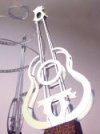
Wind Harps, also called Aeolian Harps, are among the oldest of mechanical instruments. From ancient Greece we read of a stringed box played by Aeolus, god of the wind.
In principal, the wind harp is very simple. A number of strings are placed over a sound chamber and the wind causes the strings to vibrate and thereby produce a sound. The science behind the sound is not quite so straightforward.
The Eastern Kentucky Heritage Monument will not be the first modern wind harp. There are a number of precedents.
The Saint Louis Science Center, Dallas Arboretum, The Denver Communications Building and the Port of San Diego, and others, have small wind harp sculptures- up to fifteen feet tall. The Great Puget Sound Wind Harp is twenty-six feet tall. Ours will be over twice that big.
The Eastern Kentucky Heritage Monument will have the three largest Wind Harps in the world.
Professor Henry Gurr
Dr. Henry Gurr, Professor Emeritus of Physics, University of South Carolina-Aiken, has graciously agreed to act as a consultant on our project. Professor Gurr is a nationally recognized expert in Aeolian Harps. His web site is: http://www.usca.edu/math/~mathdept/hsg/ After reaching his University Web Page, scroll down and click "Aeolian Harp."
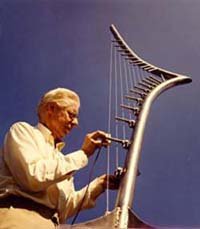
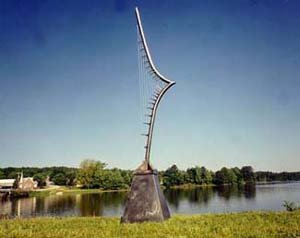
Rodney Carroll
Rodney Carroll is an amazing artist. After reaching his web sight, go to the "sculptures" link and click on the picture with the three red spires. The following picture and text are from his website.
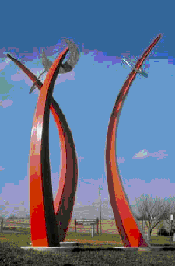
Wind Harps 1993, aluminum,
painted steel, stainless steel, H-30', L-18', W-10',
Damascus Regional Park, Damascus, Maryland.
Wind Harps are wind activated sound sculptures. Each of the three aluminum moons has five tuned wires, which vibrate with the wind. The tones and sounds vary with changes in wind speed. You may stand in the arched columns and hear the wind vibrate like a distant harpsichord in a conch shell. http://www.rodneycarroll.com/viewall.html
NF/ Observatory
The NF/ Observatory has built two marvelous wind harps. The first can be seen at www.nfo.edu/harp.htm The second, which is on a bearing and rotates, can be found at http://nfo.edu/tempestsong.htm
The NFO Windharp
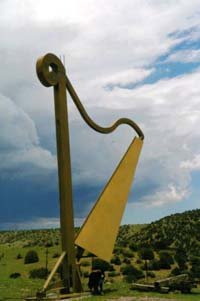 |
The following is from the NF/O web site. An Aeolian Harp built on a ridge top at the NF Ranch. (This site also has pictures of construction and other information) |
The second NF/O wind harp is called "Tempest Song."
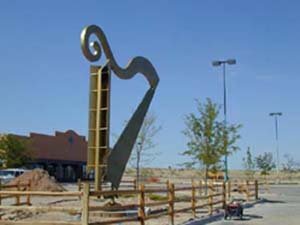
The following is from the NF/O web site. There is much more interesting information on their sites.
This is our second Windharp. The first one was built in 1998 and stands in the Mimbres Valley, in southwest New Mexico. It was noticed by Jim Long, who is building "Traditions", a New Mexico Marketplace, which features New Mexico art and products. "Traditions" will open August 5th, 2000, with a Grand Opening at the end of September. Jim commissioned us to build this harp.
Tempest Song rotates with the wind and has a venturi type wind scoop at the front to funnel high speed wind over the strings. There are 45 strings tuned to C, D, Eb, G, and Bb in three octaves. It stands 24 feet high and weighs about 3000 pounds. The bearing is from a semi truck. It was designed and built by Bill Neely and Bob Griesing in June and July of 2000. A pictorial of the construction and installation are also available. "Traditions" and the harp are located at the Budager's exit, half way between Albuquerque and Santa Fe off Interstate 25. Once you are there, the harp is very easy to find.
Ron Konzak
http://www.konzak.com/windharp/whlinks.html
Ron Konzak is the dreamer, designer and builder, with friends, of the Great Puget Sound Wind Harp. This site contains a wealth of information about wind harps in general as well as this one in particular. Furthermore, if you appreciate people who work with their hands, their head and their heart, Ron and his website offer a lot of inspiration. The following pictures and text are from his site.
The Great Puget Sound Wind Harp
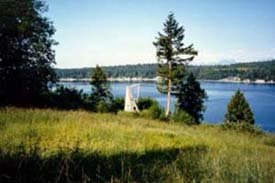
Saint Louis Wind Harp
|
The Great Puget Sound Wind Harp was featured in an issue of American
Airline's in-flight magazine, where it caught the eye of the
director of the St. Louis Science Center in Washington Park. The Science Center was planning an outdoor science park where kids could discover scientific principles while having a really good time. Ron was invited to St. Louis for an international conference on science park design, and commissioned to design a harp for the science park. This harp, which would be 13 feet high, would be fabricated in aluminum, so Ron drew up the plans, with some input from wind harp engineer Ed Hagemann. The work was done by Midwest Metal Fabricators in New Haven, Missouri, a small town in the Ozark foothills. |
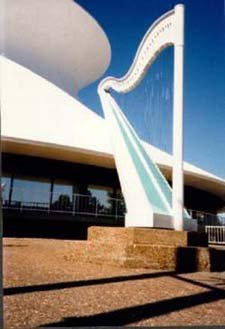 |
Lady of the Sea Wind Harp
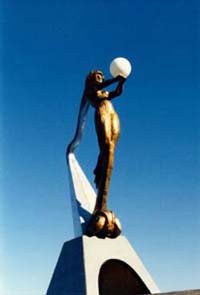 |
In 1989 the City of Anacortes, Washington, announced a contest to
design a sculpture for Cap Sante, a large rock promontory at the
entrance to the harbor. Ron envisioned a female figure, holding a light in her outstretched hands, whose body is merged into a giant harp which is played by the wind. Long-time friend and artist Jim Wegner sculpted "The Lady", whose long flowing hair became the neck of the harp. Ron crafted the overall design, and Ed Hagemann stepped in once again for the engineering. At 32 feet tall, the Lady of the Sea would be the world's largest harp. Their design won an award for making it into the final five. Unfortunately the project ran afoul of local politics, and nothing ever happened. |
Wilds Wind Harp
http://www.yourradioplace.com/wildsharp.htm
http://www.sonicarchitecture.com/html_data/env/wpavilion/wpavilion.htm
The following is from the Wilds web site. Really cool!
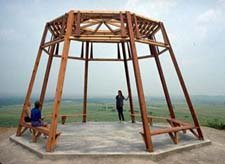
Aeolian Harp at the International Center for Wild Animals (the
Wilds), a 9000 acre wildlife refuge in Central Ohio. Zanesville, Ohio
off Route 78 between Columbus and Pittsburgh. Call (614)-638-5030 for
information.
The work offers shelter and seating for visitors as they listen to the sounds of the wind. The cedar
pavilion reflects the shape of the octagonal earth mound at the Hopewell
Indian site in Newark, Ohio. Eight copper and teakwood harps are
tensioned with stainless steel strings. Built in collaboration with Skip
Stander and Charles Bremer.
The harp transforms wind energy into musical sounds known as aeolian tones, named after Aeolus,
the god of wind in Greek mythology. The wind harp is one of the oldest
musical instruments discovered by man. According to legend, King David
hung his harp in an open window and heard it played by the wind. In more
recent times, aeolian tones can be heard singing from telephone and
power lines.
When an aeolian harp
string is activated by the wind, the fundamental is never sounded, only
the overtone series. Wind velocity is directly related to the pitch
heard by the listener; the greater the wind speed, the higher the
activated overtone. The resulting tones have a shimmering, ringing
quality.
In accordance with the
laws of fluid dynamics, when air flows past a cylinder (in this case, a
string), it sheds vortices to either side. These are shed alternatingly
in a stable and regularly repeating pattern. When the frequency of this
oscillation matches the frequency to which the string is tuned, an
aeolian tone will result. The string always vibrates in a direction
perpendicular to the wind.
Wilds Sound Walk. The Sound Walk is designed to engage the public in exploring
environmental phenomena and the sonic resources of the area. Preliminary
plans include: Textured Walkways, Listening Posts, Wind Harps, Sound
Stations, Aquaphones, and Quiet Areas. These designated sites attune the
listeners ears to the orchestration of the soundscape. Plans for
landscaping and sculptural elements employ forces of wind, water and
solar energy to create interactive areas and installations.
Other Sites of Interest
http://www.windgallery.com/wind.htm This great site offers some very interesting and artistic uses of the wind to make musical tones. The wind organs are particularly fascinating.
http://www.waldenwinds.com/ If you are interested in buying a small wind harp, definitely take a look at this site.
http://www.harmonicwindharps.com/ This is another great site if you are interested in purchasing a small, medium, or "grand" wind harp. Greg has been making Aeolian Harps for over two decades. Good general info, too.
The following websites contain general information about Wind Harps.
http://users.argonet.co.uk/artlute/aeol.html
http://members.aol.com/woinem1/index/eolsharf.htm
http://w1.neuronnexion.com/~dferment/ukplasto.htm This site has directions for making a plastic bottle wind organ. This would be a great science/art project for elementary school students.
